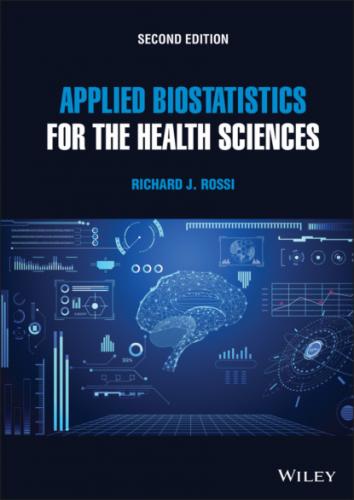Applied Biostatistics for the Health Sciences. Richard J. Rossi
Estimating Population Percentiles4.3.3 Estimating the Mean, Median, and Mode4.3.4 Estimating the Variance and Standard Deviation4.3.5 Linear Transformations4.3.6 The Plug-in Rule for Estimation4.4 Statistics for Multivariate Data Sets4.4.1 Graphical Statistics for Bivariate Data Sets4.4.2 Numerical Summaries for Bivariate Data Sets4.4.3 Fitting Lines to ScatterplotsGlossaryExercises
9 CHAPTER 5 MEASURING THE RELIABILITY OF STATISTICS5.1 Sampling Distributions5.1.1 Unbiased Estimators5.1.2 Measuring the Accuracy of an Estimator5.1.3 The Bound on the Error of Estimation5.2 The Sampling Distribution of a Sample Proportion5.2.1 The Mean and Standard Deviation of the Sampling Distribution of p5.2.2 Determining the Sample Size for a Prespecified Value of the Bound on the Error Estimation5.2.3 The Central Limit Theorem for...5.2.4 Some Final Notes on the Sampling Distribution of...5.3 The Sampling Distribution of...5.3.1 The Mean and Standard Deviation of the Sampling Distribution of...5.3.2 Determining the Sample Size for a Prespecified Value of the Bound on the Error Estimation5.3.3 The Central Limit Theorem for...5.3.4 The t Distribution5.3.5 Some Final Notes on the Sampling Distribution of...5.4 Two Sample Comparisons5.4.1 Comparing Two Population Proportions5.4.2 Comparing Two Population Means5.5 Bootstrapping the Sampling Distribution of a StatisticGlossaryExercises
10 CHAPTER 6 CONFIDENCE INTERVALS6.1 Interval Estimation6.2 Confidence Intervals6.3 Single Sample Confidence Intervals6.3.1 Confidence Intervals for Proportions6.3.2 Confidence Intervals for a Mean6.3.3 Large Sample Confidence Intervals for μ6.3.4 Small Sample Confidence Intervals for μ6.3.5 Determining the Sample Size for a Confidence Interval for the Mean6.4 Bootstrap Confidence Intervals6.5 Two Sample Comparative Confidence Intervals6.5.1 Confidence Intervals for Comparing Two Proportions6.5.2 Confidence Intervals for the Relative Risk6.5.3 Confidence Intervals for the Odds RatioGlossaryExercises
11 CHAPTER 7 TESTING STATISTICAL HYPOTHESES7.1 Hypothesis Testing7.1.1 The Components of a Hypothesis Test7.1.2 P-Values and Significance Testing7.2 Testing Hypotheses about Proportions7.2.1 Single Sample Tests of a Population Proportion7.2.2 Comparing Two Population Proportions7.2.3 Tests of Independence7.3 Testing Hypotheses About Means7.3.1 t-Tests7.3.2 t-Tests for the Mean of a Population7.3.3 Paired Comparison t-Tests7.3.4 Two Independent Sample t-Tests7.4 7.4 Some Final Comments on Hypothesis TestingGlossaryExercises
12 CHAPTER 8 SIMPLE LINEAR REGRESSION8.1 Bivariate Data, Scatterplots, and Correlation8.1.1 Scatterplots8.1.2 Correlation8.2 The Simple Linear Regression Model8.2.1 The Simple Linear Regression Model8.2.2 Assumptions of the Simple Linear Regression Model8.3 Fitting a Simple Linear Regression Model8.4 Assessing the Assumptions and Fit of a Simple Linear Regression Model8.4.1 Residuals8.4.2 Residual Diagnostics8.4.3 Estimating σ and Assessing the Strength of the Linear Relationship8.5 Statistical Inferences based on a Fitted Model8.5.1 Inferences About β08.5.2 Inferences About β18.6 Inferences about the Response Variable8.6.1 Inferences About μY|X8.6.2 Inferences for Predicting Values of Y8.7 Model Validation8.7.1 Selecting the Training and Validation Data Sets8.7.2 Validating a Fitted Model8.8 Some Final Comments on Simple Linear RegressionGlossaryExercises
13 CHAPTER 9 MULTIPLE REGRESSION9.1 Investigating Multivariate Relationships9.2 The Multiple Linear Regression Model9.2.1 The Assumptions of a Multiple Regression Model9.3 Fitting a Multiple Linear Regression Model9.4 Assessing the Assumptions of a Multiple Linear Regression Model9.4.1 Residual Diagnostics9.4.2 Detecting Multivariate Outliers and Influential Observations9.5 Assessing the Adequacy of Fit of a Multiple Regression Model9.5.1 Estimating σ9.5.2 The Coefficient of Determination9.5.3 Multiple Regression Analysis of Variance9.6 Statistical Inferences-Based Multiple Regression Model9.6.1 Inferences about the Regression Coefficients9.6.2 Inferences About the Response Variable9.7 Comparing Multiple Regression Models9.8 Multiple Regression Models with Categorical Variables9.8.1 Regression Models with Dummy Variables9.8.2 Testing the Importance of Categorical Variables9.9 Variable Selection Techniques9.9.1 Model Selection Using Maximum R2adj9.9.2 Model Selection using BIC9.10 Model Validation9.10.1 Selecting the Training and Validation Data Sets9.10.2 Validating a Fitted Model9.11 Some Final Comments on Multiple RegressionGlossaryExercises
14 CHAPTER 10 LOGISTIC REGRESSION10.1 The Logistic Regression Model10.1.1 Assumptions of the Logistic Regression Model10.2 Fitting a Logistic Regression Model10.3 Assessing the Fit of a Logistic Regression Model10.3.1 Checking the Assumptions of a Logistic Regression Model10.3.2 Testing for the Goodness of Fit of a Logistic Regression Model10.3.3 Model Diagnostics10.4 Statistical Inferences Based on a Logistic Regression Model10.4.1 Inferences about the Logistic Regression Coefficients10.4.2 Comparing Models10.5 Variable Selection10.6 Classification with Logistic Regression10.6.1 The Logistic Classifier10.6.2 Misclassification Errors10.7 Some Final Comments on Logistic RegressionGlossaryExercises
15 CHAPTER 11 DESIGN OF EXPERIMENTS11.1 Experiments Versus Observational Studies11.2 The Basic Principles of Experimental Design11.2.1 Terminology11.2.2 Designing an Experiment11.3 Experimental Designs11.3.1 The Completely Randomized Design11.3.2 The Randomized Block Design11.4 Factorial Experiments11.4.1 Two-Factor Experiments11.4.2 Three-Factor Experiments11.5 Models for Designed Experiments11.5.1 The Model for a Completely Randomized Design11.5.2 The Model for a Randomized Block Design11.5.3 Models for Experimental Designs with a Factorial Treatment Structure11.6 Some Final Comments of Designed ExperimentsGlossaryExercises
16 CHAPTER 12 ANALYSIS OF VARIANCE12.1 Single-Factor Analysis of Variance12.1.1 Partitioning the Total Experimental Variation12.1.2 The Model Assumptions12.1.3 The F-test12.1.4 Comparing Treatment Means12.2 Randomized Block Analysis of Variance12.2.1 The ANOV Table for the Randomized Block Design12.2.2 The Model Assumptions12.2.3 The F-test12.2.4 Separating the Treatment Means12.3 Multi factor Analysis of Variance12.3.1 Two-Factor Analysis of Variance12.3.2 Three-Factor Analysis of Variance12.4 Selecting the Number of Replicates in Analysis of Variance12.4.1 Determining the Number of Replicates from the Power12.4.2 Determining the Number of Replicates from D12.5 Some Final Comments on Analysis of VarianceGlossaryExercises
17 CHAPTER 13 SURVIVAL ANALYSIS13.1 The Kaplan–Meier Estimate of the Survival Function13.2 The Proportional Hazards Model13.3 Logistic Regression and Survival Analysis13.4 Some Final Comments on Survival AnalysisGlossaryExercises
18 REFERENCES
19 APPENDIX A
21 INDEX
List of Illustrations
1 Chapter 2Figure 2.1 Different types of classifications...Figure 2.2 Weight-by-age chart for girls in the NHANES study.Figure 2.3 A bar chart of the...Figure 2.4 A bar chart of the...Figure 2.5 An example of a mound-shaped distribution.Figure 2.6 An example of a distribution...Figure 2.7 An example of a distribution...Figure 2.8 An example of a bimodal...Figure 2.9 Distribution of age at which...Figure 2.10 Distribution of the age at...Figure 2.11
